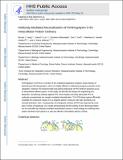Antibody-Mediated Neutralization of Perfringolysin O for Intracellular Protein Delivery
Author(s)
Yang, Nicole Jie Yeon; Sklaviadis, Demetra; Wittrup, Karl Dane; Gui, Dan Yi; Vander Heiden, Matthew G.; Liu, David V.; ... Show more Show less
DownloadAntibody-mediated neutralization.pdf (735.5Kb)
PUBLISHER_POLICY
Publisher Policy
Article is made available in accordance with the publisher's policy and may be subject to US copyright law. Please refer to the publisher's site for terms of use.
Terms of use
Metadata
Show full item recordAbstract
Perfringolysin O (PFO) is a member of the cholesterol-dependent cytolysin (CDC) family of bacterial pore-forming proteins, which are highly efficient in delivering exogenous proteins to the cytoplasm. However, the indiscriminate and potent cytotoxicity of PFO limits its practical use as an intracellular delivery system. In this study, we describe the design and engineering of a bispecific, neutralizing antibody against PFO, which targets reversibly attenuated PFO to endocytic compartments via receptor-mediated internalization. This PFO-based system efficiently mediated the endosomal release of a co-targeted gelonin construct with high specificity and minimal toxicity in vitro. Consequently, the therapeutic window of PFO was improved by more than 5 orders of magnitude. Our results demonstrating that the activity of pore-forming proteins can be controlled by antibody-mediated neutralization present a novel strategy for utilizing these potent membrane-lytic agents as a safe and effective intracellular delivery vehicle.
Date issued
2015-04Department
Massachusetts Institute of Technology. Department of Biological Engineering; Massachusetts Institute of Technology. Department of Biology; Massachusetts Institute of Technology. Department of Chemical Engineering; Koch Institute for Integrative Cancer Research at MITJournal
Molecular Pharmaceutics
Publisher
American Chemical Society (ACS)
Citation
Yang, Nicole J. et al. “Antibody-Mediated Neutralization of Perfringolysin O for Intracellular Protein Delivery.” Molecular Pharmaceutics 12.6 (2015): 1992–2000.
Version: Author's final manuscript
ISSN
1543-8384
1543-8392